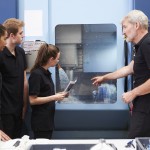Outside of large urban districts, regional vocational schools provide full-time CTE options. Massachusetts is a prime example, where Shaun M. Dougherty has done the best work. He uses an instrumental-variables approach to examine the impacts of these schools. And lest you doubt his sincerity in his belief of whether this approach provides plausible claims about cause and effect, see the title of his 2016 article, “The Effect of Career and Technical Education on Human Capital Accumulation: Causal Evidence from Massachusetts.”
“If we want all of our young people to have the opportunity to thrive, it is more important than ever that high schools be designed to maximize the chances that students will graduate, and that when they do, they are prepared to enter college or have skills valued in the labor force,” says Shaun Dougherty.
Despite the education community’s clear polarization over the appointment of Betsy DeVos as the next U.S. secretary of education, there may be a silver lining in her confirmation—specifically, for those in the career and technical education (CTE) community.
Ask any group of high school teachers, and they will report that the most frequently asked question in their classrooms is, “When are we ever gonna use this?” In a traditional college prep program, the honest answer is usually, “Maybe when you get to the university.” But in the real world? Depending on the class, students may not find their learning as useful.
Two Neag School faculty members in the Department of Educational Leadership have recently received funding — totaling more than $2 million — from the U.S. Department of Education’s Institute of Education Sciences (IES), as part of the latest round of grants issued by the National Center for Education Research (NCER)’s Education Research Grants Program.
A new study finds that some career and technical education students are more likely to graduate from high school, actually do better in college, and earn higher wages than their peers. The report’s author, Shaun Dougherty, joins this podcast to talk about his findings.
When students feel engaged and connected to their schoolwork, it’s no surprise that they tend to have better academic outcomes. But a new study of career and technical education programs suggests the benefits can extend well beyond high school graduation.
Research findings from Shaun Dougherty, assistant professor of educational leadership in the Neag School of Education, are the focus of two recently released reports focused on the topic of career and technical education (CTE), or what was once known as vocational education. Each report — the first of which was released in late March by the Manhattan Institute and a […]
One of the most striking trends this year: how many young people from all parts of the city and all backgrounds chose what used to be called a “vocational” high school program – now renamed and reimagined as “career and technical education,” or CTE.
Career and technical education (CTE) schools and academies are important and impactful, but they’re also scarce and expensive. To develop the skills of the millions of students who want high-quality CTE, we must be more egalitarian in the ways students access it—and the prospects for economic stability and success that it can create.


